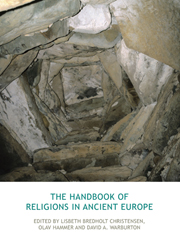Book contents
- Frontmatter
- Contents
- A note on Greek and Latin sources
- Abbreviations and short titles
- 1 Introduction
- PART I PREHISTORIC RELIGIONS
- 2 Studying prehistoric religions
- 3 Prehistoric material and religion: a personal odyssey
- 4 Francesco d'Errico and the origins of religion
- 5 On Palaeolithic religion
- 6 Ian Hodder and the Neolithic
- 7 Neolithic cult images? The testimony of figurines for Neolithic religion
- 8 Religious practices in northern Europe 4000–2000 BCE
- 9 Mythological aspects of Nordic Bronze Age religion
- 10 Religion and society in the Bronze Age
- 11 The religions of prehistoric Europe and the study of prehistoric religion
- PART II ANCIENT EUROPE IN THE HISTORICAL PERIOD
- Timeline of key dates
- Contributors
- References
- Index
11 - The religions of prehistoric Europe and the study of prehistoric religion
from PART I - PREHISTORIC RELIGIONS
- Frontmatter
- Contents
- A note on Greek and Latin sources
- Abbreviations and short titles
- 1 Introduction
- PART I PREHISTORIC RELIGIONS
- 2 Studying prehistoric religions
- 3 Prehistoric material and religion: a personal odyssey
- 4 Francesco d'Errico and the origins of religion
- 5 On Palaeolithic religion
- 6 Ian Hodder and the Neolithic
- 7 Neolithic cult images? The testimony of figurines for Neolithic religion
- 8 Religious practices in northern Europe 4000–2000 BCE
- 9 Mythological aspects of Nordic Bronze Age religion
- 10 Religion and society in the Bronze Age
- 11 The religions of prehistoric Europe and the study of prehistoric religion
- PART II ANCIENT EUROPE IN THE HISTORICAL PERIOD
- Timeline of key dates
- Contributors
- References
- Index
Summary
In this chapter we take the liberty of looking critically at the contributions of the first section of this book. We do so on the assumption that crossing disciplinary borders is difficult: archaeologists have difficulties in discussing religion since religion is assumed to take place in the mind (in the form of ideas and thoughts, and thus in a form which is completely inaccessible in prehistory). Likewise, scholars of religion have difficulties speaking about prehistory, since they have no methodological tools for dealing with material culture (at least without any textual or verbal support whatsoever).
Furthermore, there are other issues which do not normally appear to be problematic in the study of religion. When studying known religions, there is no danger of confusing science and religion, and little of confounding myth and history. Given the neglect of material culture, the importance of art is likewise minimal. In these chapters we have seen how mankind gradually developed a capacity for artistic expression and later exploited iconography to depict the course of the sun. In these pages, religion was associated with social changes and group identities, without any gods. Yet according to the study of religion, religion and its elements are clearly a world apart – so far in fact, that Pascal Boyer (2001) can propose that religious thought is by nature counterintuitive.
- Type
- Chapter
- Information
- The Handbook of Religions in Ancient Europe , pp. 93 - 100Publisher: Acumen PublishingPrint publication year: 2013

